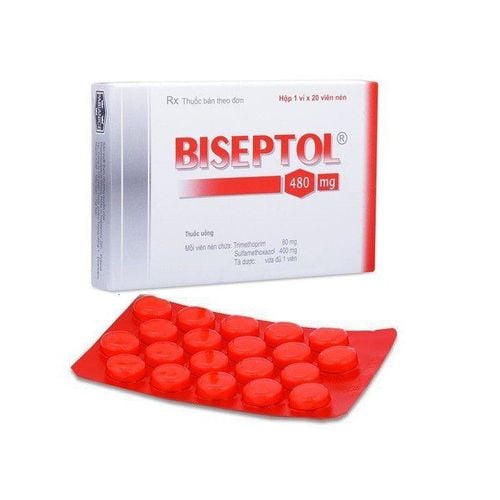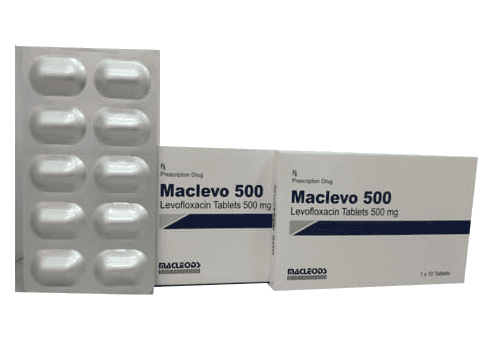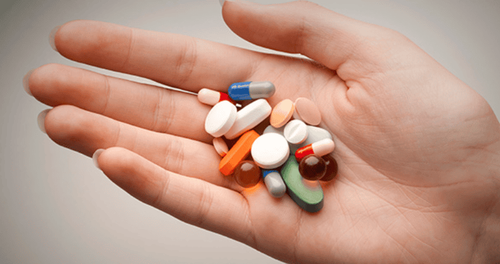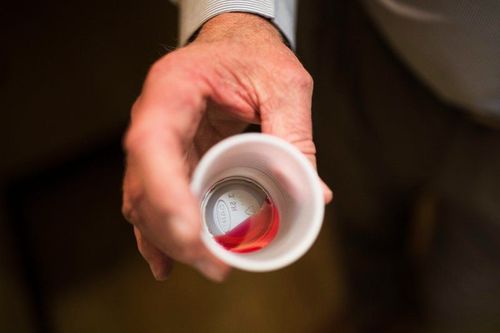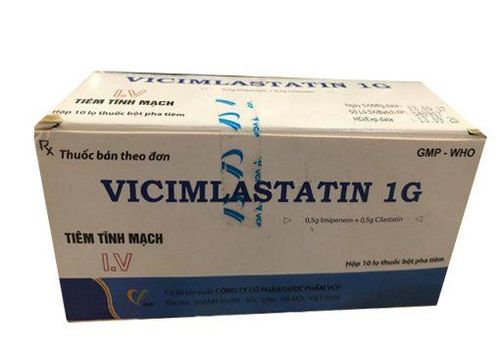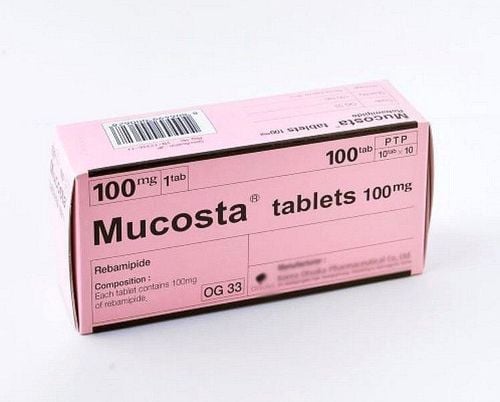This is an automatically translated article.
Cipmyan medicine 500mg is prepared in the form of film-coated tablets, the composition is Ciprofloxacin. The drug is used to treat certain infections. The following article will provide more about the effects and how to use Cipmyan 500mg effectively.1. Uses of Cipmyan 500mg
What is Cipmyan 500? 1 tablet contains Ciprofloxacin 500mg. Ciprofloxacin is a semi-synthetic antibiotic, belonging to the fluoroquinolone group, with a broad spectrum of antibacterial activity. The drug works to kill bacteria by inhibiting the enzymes DNA gyrase and topoisomerase IV (the enzymes necessary for the reproduction of bacterial DNA), preventing the replication of chromosomes that prevent bacteria from reproducing. . Ciprofloxacin is active against bacteria that are already resistant to antibiotics of other groups. At the same time, this ingredient also has a bactericidal effect in both the fast and slow growth stages of bacteria.What are the effects of Cipmyan 500? Cipmyan 500mg is indicated in the following cases:
Treatment of severe infections for which conventional antibiotics are ineffective in order to avoid the development of bacteria resistant to Ciprofloxacin; Treatment of infections caused by susceptible agents such as: Urinary tract infections (upper and lower); Biliary tract infections, chancroid, prostatitis, infected insect bites or stings; Bone - joint infections, otitis - nose - throat infections (including otitis externa, otitis media and sinusitis), severe pancreatic cystic fibrosis, osteomyelitis - bone marrow; Infections in people at risk of immunosuppression (neutropenia in immunocompromised patients), anthrax; Endocarditis caused by HACEK bacteria, gastroenteritis including cholera, salmonella, rectal dysentery, campylobacter, enteritis caused by Yersinia, gonorrhea, pelvic inflammatory disease, inguinal granuloma, peritonitis, plague; Lower respiratory tract infections including Pseudomonas infections in people with cystic fibrosis of the pancreas, Rickettsia infections, typhoid, paratyphoid, bacteremia; Treatment of skin or skin structure infections caused by gram-negative bacteria (although the fluoroquinolone group is also active against gram-positive bacteria); Prophylaxis of meningococcal disease and surgical infections, treatment of non-tuberculous mycobacterial infections; Treatment of eye and ear infections (topical use). Indications in children: Ciprofloxacin is not recommended in children under 18 years of age. However, the drug is still licensed for use in severe cases, in children over 1 year of age such as prophylaxis and treatment of aspiration anthrax, lower respiratory tract infections caused by Pseudomonas aeruginosa in children with cystic fibrosis and some infections. Other serious bacteria (urinary tract infections complicated by nephritis, pyelonephritis). In addition, although not yet approved, the drug is still indicated for use in skin anthrax, gastrointestinal anthrax, treatment of gonorrhea, prevention of meningococcal meningitis in children over 12 years old.
Contraindications to using Cipmyan 500mg:
People with a history of hypersensitivity to Ciprofloxacin or its components or other quinolones; Persons being treated with tizanidine; People who are pregnant and in the lactation period (unless it is mandatory).
2. How to take Cipmyan 500mg
Cipmyan 500mg is taken orally. Patients should pay attention not to take the drug with milk, yogurt, calcium-fortified products (such as fruit juice) alone (without meals) because it will reduce drug absorption. It is best to take the medicine 2 hours before or after taking calcium-fortified products or taking a lot of calcium (over 800mg).Patients should take Cipmyan 500mg with plenty of water and not take anti-acid medicine within 2 hours after taking the medicine.
3. Dosage of Cipmyan 500mg
Dosage of Cipmyan will depend on the type of infection as well as the severity / mildness of the disease. Dosage should be determined based on the patient's clinical and microbiological response. In general, for most infections, treatment should continue for at least 48 hours after the patient is symptom-free. Duration of treatment is usually 1 to 2 weeks, but for severe or complicated infections, longer treatment may be required.Treatment with Cipmyan may need to be continued for 4-6 weeks or longer in patients with osteoarticular infections. If diarrheal infection is present, the drug is usually given for 3-7 days or possibly shorter.
3.1 Dosage of Cipmyan in children
General dose: Oral 20mg/kg (maximum 750mg) x 2 times/day.For young children:
Newborns: Use dose 15mg/kg x 2 times/day; 1 month - 18 years: Dose 20mg/kg (maximum 750mg) x 2 times/day or 10mg/kg (maximum 400mg) x 3 times/day. Some special indications for children:
Anthrax infection in the airways: Oral 15mg/kg/time, every 12 hours/time, treatment for 60 days, maximum dose is 500mg/time; Skin anthrax infections: Take 10-15mg/kg/time, every 12 hours, treat for 60 days, the maximum dose is 1g/time. When the patient's clinical symptoms have improved, use amoxicillin 80mg/kg/day in 3 divided doses, every 8 hours to achieve a complete therapeutic effect; Infectious conjunctivitis: Use the same dose as adults; Complicated urinary tract infection or pyelonephritis: Take 20 - 30 mg/kg/day, divided into 2 times, 12 hours apart, perform treatment for 10-21 days, maximum dose is 1.5g/day ; Prophylaxis of meningitis : Oral use with children 1 month - 5 years old is a single dose of 125mg; children 5 - 12 years old is a single dose of 250mg; children 12 - 18 years old is a single dose of 500mg; Corneal ulcer: Take 250-750mg, every 12 hours.
3.2 Dosage of Cipmyan in adults
Usual dose in adults is as follows:Anthrax infections in the airways (post-exposure prophylaxis): Oral dose of 500mg/time, every 12 hours, treatment for 60 days; Skin anthrax infection (treatment): Oral dose of 500mg/time, every 12 hours, treatment for 60 days; Bone/joint infections: Oral dose of 500 - 750mg/time, 2 times/day, perform treatment for 4-6 weeks; Canker sores: Take a dose of 500mg/time, 2 times/day, perform treatment for 3 days; Hedgehog endocarditis (HACEK): Cipmyan 500mg should only be used if treatment with beta-lactam antibiotics is ineffective (should not be the first choice). Oral dose of 500mg / time, 12 hours apart, treatment for 4 weeks; Gonorrhea: If it is uncomplicated gonorrhea, take a single dose of 250 - 500mg (can be used concurrently with azithromycin or doxycycline when Chlamydia may be infected). If it is disseminated gonorrhea, oral dose of 500mg / time x 2 times / day, treatment for 7 days (first treatment with ceftriaxone 1g / day, for 24 - 48 hours). Fluoroquinolone antibiotics should not be used for complicated or severe gonorrhea, unless there are no other options or when the culture is still susceptible; Infectious diarrhea: If it is Salmonella infection, the dose is 500mg/time x 2 times/day, treatment is carried out for 5-7 days. If it is Shigella infection, the dose is 500mg / time x 2 times / day, treatment for 3 days; Diarrhea in travelers: If the disease is mild, use 1 dose of 750mg; if the disease is serious, the dose is 500mg/time x 2 times/day, treatment is carried out for 3 days; Vibrio cholerae infection: Use 1 dose of 1g; Intra-abdominal infections: Oral dose of 500mg/time, every 12g hourly, treatment for 7-14 days; Infections of the lower respiratory tract or skin structures: Oral dose of 500 - 750m / time x 2 times / day, perform treatment for 7-14 days; Prostatitis (chronic due to bacterial infection): Oral dose of 500mg/time, every 12 hours/time, treatment for 28 days; Acute sinusitis: Oral dose of 500mg/time, every 12 hours/time, perform treatment for 10 days; Typhoid : Oral dose of 500 - 750mg / time, every 12 hours / time, treatment for 7-14 days; Urinary tract infection: If it is an acute, uncomplicated, cystitis, the dose is 250mg/time, every 12 hours, for 4 days. If it is a complicated form of inflammation (including pyelonephritis), the dose is 500mg/time, every 12 hours, for 7-14 days. Dosage of Cipmyan 500mg in patients with renal failure:
| Độ thanh thải creatinin [mL/min/1.73 m2] | Creatinin huyết thanh [pmol/L] | Liều dùng đường uống [mg] |
| > 60 | < 124 | Xem liều thường dùng |
| 30 - 60 | 124 - 168 | 250 - 500mg mỗi 12h |
| < 30 | > 169 | 250 - 500mg mỗi 24h |
| Người bệnh nhân thẩm tách máu | > 169 | 250 - 500mg mỗi 24h (sau thẩm tách) |
| Người bệnh chạy thận nhân tạo | > 169 | 250 - 500mg mỗi 24h |
Overdose: There is no specific antidote for Ciprofloxacin. An overdose of 12g causes mild symptoms of toxicity. Acute overdose of 16g causes acute renal failure. Overdose symptoms commonly include: Dizziness, headache, fatigue, tremor, hallucinations, convulsions, confusion, liver failure, abdominal discomfort, kidney, crystalluria, and hematuria. Routine first aid measures include emesis, gastric lavage, and diuresis. In addition, adequate fluid resuscitation, renal function monitoring, and oral administration of magnesium or calcium-containing antacids should be required to reduce the absorption of Ciprofloxacin. Only small amounts of Ciprofloxacin are eliminated by hemodialysis or peritoneal dialysis. In case of overdose, symptomatic treatment and electrocardiographic monitoring are required because of the possibility of QT prolongation.
Missed dose: You should add 1 dose of Cipmyan as soon as you remember. If it is almost time for your next dose, skip the missed dose and continue with your usual dosing schedule.
4. Cipmyan 500mg . side effects
When using Cipmyan 500mg, patients may experience unwanted side effects:Common: Dizziness, insomnia, anxiety, restlessness, fever, skin rash, nausea, vomiting, diarrhea , abdominal pain, dyspepsia, increased liver ALT and AST, rhinitis; Uncommon: Headache, fever, eosinophilia, polymorphonuclear leukopenia, lymphopenia, thrombocytopenia, anemia, tachycardia, agitation, gastrointestinal disturbances, rash, skin pruritus, superficial phlebitis, temporary increase in creatinine, increased bilirubin and alkaline phosphatase in the blood, pain and swelling of the joints; Rare: Hemolytic anemia, thrombocytosis, leukocytosis, altered prothrombin levels, convulsions, confusion, paranoia, psychosis, depression, insomnia, behavioral disturbances, confusion vision, hearing disturbances, taste and smell disturbances, increased intracranial pressure, tinnitus, pseudomembranous colitis, skin-mucosal syndrome, vasculitis, erythema nodosum, Lyell's syndrome , exudative erythema, hepatocellular necrosis, hepatitis, cholestatic jaundice, myalgia, tendinitis and surrounding tissue, tendon rupture (especially in the elderly when taking drugs in combination with corticosteroids) , with crystalluria when urine is alkaline, hematuria, interstitial nephritis, acute renal failure. How to deal with side effects of Cipmyan 500mg:
To avoid crystalluria, you should maintain enough water intake and do not let the urine be too alkaline; If diarrhea is severe and persists during and after treatment, and the patient may have severe bowel disturbances (pseudomembranous colitis), Ciprofloxacin should be discontinued and an appropriate antibiotic substitute (eg. Vancomycin ); If there are signs of side effects from the drug, the patient should stop taking Ciprofloxacin and notify the doctor immediately, go to the hospital (although the side effects are usually mild, and quickly disappear when the drug is stopped).
5. Be careful when using Cipmyan 500mg
Some notes users need to remember when using Cipmyan 500mg:Caution when using Ciprofloxacin for people with a history of epilepsy, central nervous system disorders, patients with liver or kidney failure, people with myasthenia gravis. , the patient lacks glucose-6-phosphate dehydrogenase; It is recommended to maintain adequate water intake during treatment with Ciprofloxacin, to avoid changing urine too alkaline (due to the risk of crystalluria); Cipmyan 500mg should not be used by people under 18 years of age, pregnant women, or nursing mothers unless absolutely necessary, the benefits of the drug outweigh the risks (because of Ciprofloxacin and related fluoroquinolones such as nalidixic acid. can cause cartilage degeneration in weight-bearing joints); Tendonitis or tendon rupture may occur with quinolone antibiotics. This risk is increased with concomitant use of corticosteroids, patients over 60 years of age and organ transplant recipients; Discontinue ciprofloxacin if the patient develops pain, swelling, and rupture of the tendon. Thereafter, the use of fluoroquinolones should be contraindicated in this group of patients; During treatment with Ciprofloxacin, exposure to high-powered lights and sunlight should be avoided during intense sunlight; Use with caution in the elderly because of the increased risk of QT prolongation; Pay attention to the risk of sensitization, anaphylactic reactions, and death. Should stop the drug when there are signs of rash, other hypersensitivity; When taking Ciprofloxacin, it is necessary to avoid exertion, heavy exercise because it will increase the risk of tendon rupture; Long-term use of Ciprofloxacin may overgrow bacteria that are not sensitive to the drug. It is necessary to monitor the patient, make regular antibiotic maps for appropriate treatment according to the antibiotic chart; Ciprofloxacin may cause tests for Mycobacterium tuberculosis to be negative; Ingredients Ciprofloxacin can cause dizziness, lightheadedness, affect the operation of machines or vehicles, especially when drinking alcohol; Avoid or use with caution in patients with prolonged QT interval or associated risk factors such as: bradycardia, uncontrolled electrolyte disturbances, pre-existing heart disease; Limit caffeine use if cardiac disturbances and overstimulation occur; Ciprofloxacin and fluoroquinolones should be avoided in MRSA infections due to the high degree of resistance.
6. Cipmyan 500mg . drug interactions
Some drug interactions of Cipmyan 500mg include:Concomitant use of ciprofloxacin with clozapine, ropinirol, theophylline, tizanidin may increase serum concentrations of these drugs. Therefore, concurrent use of Ciprofloxacin with tizanidin is contraindicated, blood theophylline levels should be checked, theophylline dose can be reduced if the two drugs are required; with clozapine and ropinirol can be used under clinical supervision with dose adjustment as necessary; Ciprofloxacin may potentiate the effects of oral anticoagulants such as warfarin and the oral antidiabetic drug glibenclamide. Blood prothrombin or blood glucose should be regularly checked when these drugs are used; Ciprofloxacin may potentiate the effects of caffeine, bendamustin, corticosteroids, and pentoxifylin. Ciprofloxacin may inhibit renal tubular secretion of methotrexate, increasing its toxicity; Concomitant use of Ciprofloxacin with non-steroidal anti-inflammatory drugs such as ibuprofen or indomethacin or insulin will increase the side effects of Ciprofloxacin; Ions such as aluminum, calcium, magnesium, zinc and iron reduce the absorption of oral ciprofloxacin when taken concomitantly. Iron preparations such as gluconate, sulfate, fumarate will significantly reduce the absorption of Ciprofloxacin in the intestine; zinc-containing preparations have less effect; Avoid concomitant administration of ciprofloxacin with zinc or iron preparations, and should be taken as far apart as possible. Co-administration of aluminum and magnesium-containing antacids will reduce serum concentrations of ciprofloxacin and decrease the bioavailability of ciprofloxacin. Therefore, Ciprofloxacin should not be taken with anti-acid drugs, should be taken apart (take an antacid 2 - 4 hours before taking Ciprofloxacin); If Ciprofloxacin is used concurrently with cytotoxic drugs (vincristin, doxorubicin, cytosin arabinoside, cyclophosphamide, mitozantron), the absorption of Ciprofloxacin may be reduced by 1⁄2; If Ciprofloxacin is used together with didanosine, the concentration of Ciprofloxacin will be significantly reduced. Therefore, Ciprofloxacin should be taken 2 hours before didanosine or 6 hours after didanosine; Taking Ciprofloxacin with sucralfate reduces the absorption of Ciprofloxacin. Ciprofloxacin should be taken 2 - 6 hours before taking sucralfate; Concomitant administration of ciprofloxacin and cyclosporin may cause an increase in serum creatinine. Therefore, it is necessary to check blood creatinine twice a week; When ciprofloxacin is co-administered with phenytoin, serum phenytoin concentrations are altered; Ciprofloxacin may reduce the effect of phenytoin, mycophenolate, sulfonylurea, typhoid vaccine; Avoid taking Ciprofloxacin with procainamide, amiodarone, quinidine, sotalol and other drugs in the same class. Concomitant use of ciprofloxacin should be avoided with the antihistamines astemizol and terfenadine, erythromycin, pentamidine, cisapride, phenothiazines or tricyclic antidepressants; Probenecid reduces the glomerular filtration rate, reduces renal tubular secretion, so it will reduce the urinary excretion of Ciprofloxacin, increasing the concentration of Ciprofloxacin in the plasma. During the course of using Cipmyan 500mg, patients should strictly follow the doctor's instructions. If you experience side effects, the patient should immediately notify the doctor for timely treatment.
Please dial HOTLINE for more information or register for an appointment HERE. Download MyVinmec app to make appointments faster and to manage your bookings easily.




